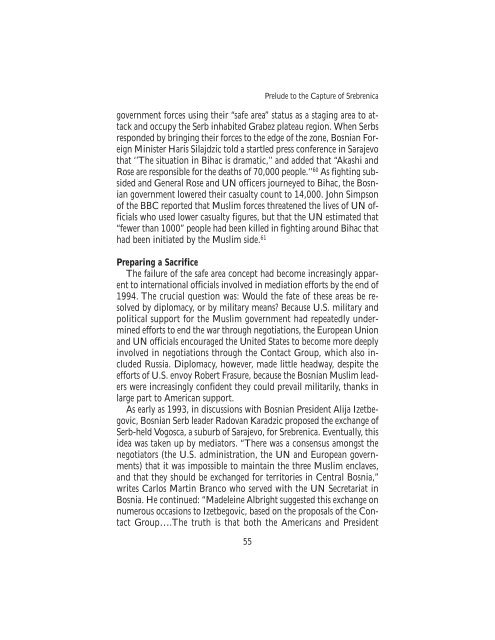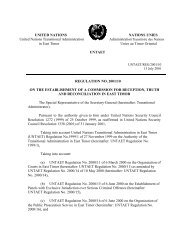The Srebrenica Massacre - Nova Srpska Politicka Misao
The Srebrenica Massacre - Nova Srpska Politicka Misao
The Srebrenica Massacre - Nova Srpska Politicka Misao
You also want an ePaper? Increase the reach of your titles
YUMPU automatically turns print PDFs into web optimized ePapers that Google loves.
Prelude to the Capture of <strong>Srebrenica</strong><br />
government forces using their “safe area” status as a staging area to attack<br />
and occupy the Serb inhabited Grabez plateau region. When Serbs<br />
responded by bringing their forces to the edge of the zone, Bosnian Foreign<br />
Minister Haris Silajdzic told a startled press conference in Sarajevo<br />
that ‘’<strong>The</strong> situation in Bihac is dramatic,’’ and added that “Akashi and<br />
Rose are responsible for the deaths of 70,000 people.‘’ 60 As fighting subsided<br />
and General Rose and UN officers journeyed to Bihac, the Bosnian<br />
government lowered their casualty count to 14,000. John Simpson<br />
of the BBC reported that Muslim forces threatened the lives of UN officials<br />
who used lower casualty figures, but that the UN estimated that<br />
“fewer than 1000” people had been killed in fighting around Bihac that<br />
had been initiated by the Muslim side. 61<br />
Preparing a Sacrifice<br />
<strong>The</strong> failure of the safe area concept had become increasingly apparent<br />
to international officials involved in mediation efforts by the end of<br />
1994. <strong>The</strong> crucial question was: Would the fate of these areas be resolved<br />
by diplomacy, or by military means? Because U.S. military and<br />
political support for the Muslim government had repeatedly undermined<br />
efforts to end the war through negotiations, the European Union<br />
and UN officials encouraged the United States to become more deeply<br />
involved in negotiations through the Contact Group, which also included<br />
Russia. Diplomacy, however, made little headway, despite the<br />
efforts of U.S. envoy Robert Frasure, because the Bosnian Muslim leaders<br />
were increasingly confident they could prevail militarily, thanks in<br />
large part to American support.<br />
As early as 1993, in discussions with Bosnian President Alija Izetbegovic,<br />
Bosnian Serb leader Radovan Karadzic proposed the exchange of<br />
Serb-held Vogosca, a suburb of Sarajevo, for <strong>Srebrenica</strong>. Eventually, this<br />
idea was taken up by mediators. “<strong>The</strong>re was a consensus amongst the<br />
negotiators (the U.S. administration, the UN and European governments)<br />
that it was impossible to maintain the three Muslim enclaves,<br />
and that they should be exchanged for territories in Central Bosnia,”<br />
writes Carlos Martin Branco who served with the UN Secretariat in<br />
Bosnia. He continued: “Madeleine Albright suggested this exchange on<br />
numerous occasions to Izetbegovic, based on the proposals of the Contact<br />
Group….<strong>The</strong> truth is that both the Americans and President<br />
55



